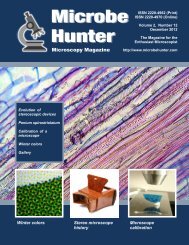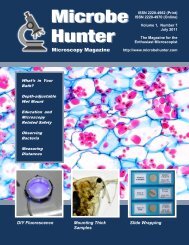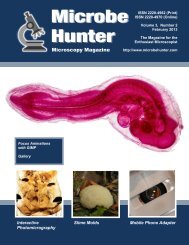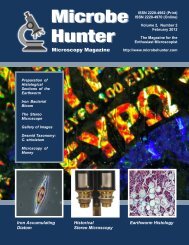October 2012 - MicrobeHunter.com
October 2012 - MicrobeHunter.com
October 2012 - MicrobeHunter.com
You also want an ePaper? Increase the reach of your titles
YUMPU automatically turns print PDFs into web optimized ePapers that Google loves.
Gram Staining<br />
Technique<br />
The procedure<br />
The bacteria are taken either from a<br />
liquid culture or agar medium. Christian<br />
Gram took the samples directly from<br />
lung tissue. The bacteria are then<br />
smeared on a microscope slide, airdried<br />
and heat-fixed. For heat-fixing,<br />
the slide is pulled 2 times through the<br />
flame of a Bunsen burner, with the sample<br />
pointing away from the flame. This<br />
process "bakes" the bacteria to the glass<br />
slide and prevents them from being<br />
washed away during the staining process.<br />
The primary stain crystal violet is<br />
then applied to the fixed bacteria for 1-3<br />
minutes. Gram's iodine solution is then<br />
added. The iodine causes the formation<br />
of stained <strong>com</strong>plexes inside of the bacterial<br />
cells. The bacteria are then carefully<br />
rinsed with alcohol. The alcohol is<br />
able to dissolve these <strong>com</strong>plexes, but is<br />
only to wash out the dye in bacteria<br />
which have a thin cell wall (Gram negative).<br />
Cells with a thick cell wall retain<br />
the dye (Gram positive). Last, the cells<br />
are counter-stained with a deep red safranin<br />
dye to make the cells visible again,<br />
which have lost the color in the washing<br />
step.<br />
Gram negative bacteria have a thin<br />
cell wall between two membranes,<br />
while Gram positive species have a<br />
thick cell wall outside of a single cell<br />
membrane. The Gram positive bacteria<br />
represent a distinct line in the phylogenetic<br />
tree of life, which was established<br />
using genetic studies. The Gram staining<br />
procedure therefore differentiates<br />
the bacteria based on their phylogenetic<br />
relatedness.<br />
Personal experiences<br />
During my work in the microbiological<br />
laboratory, I have performed countless<br />
Gram stains, with varying success.<br />
I have discovered, that the reproducibility<br />
of the procedure depends much on<br />
the age of the culture. Some bacteria<br />
behave differently depending on whether<br />
the bacterial culture is still actively<br />
growing or stationary. Gram positive<br />
cells that are too old might appear as<br />
being Gram negative. I even remember<br />
one instance in which a pure culture of<br />
a bacterial species had cells which<br />
stained both Gram positive and Gram<br />
negative. Evidently some of the cells in<br />
the culture were already too old to retain<br />
the stain, while others were still young<br />
enough to stain as expected.<br />
Sometimes the optics of the microscope<br />
also <strong>com</strong>plicated the matter.<br />
Phase contrast optics generally made<br />
the cells appear darker and occasionally<br />
it was difficult to identify the true color<br />
of the cells. In bright-field systems,<br />
closing the condenser diaphragm too<br />
much also introduces refractive patterns<br />
around the cells, especially if the refractive<br />
index of the bacteria is very different<br />
from the surrounding medium. This<br />
too made the staining reaction difficult<br />
to see.<br />
Impatience is also a problem. It is<br />
not advisable to speed up the drying<br />
process of the bacterial suspension by<br />
heating the slide. This will cause the<br />
cells to burst and they will stain Gram<br />
negative because the blue–purple color<br />
<strong>com</strong>plex can then be washed out of the<br />
cells.<br />
Last, some bacterial strains are<br />
Gram-indeterminate. This means that<br />
they do not respond well to the staining<br />
procedure and can not be distinguished<br />
this way. With all of these uncertainties,<br />
it is not surprising that molecular methods,<br />
such as DNA analysis, have gained<br />
so much popularity in recent years.<br />
References<br />
Gram, C. 1884. Über die isolierte Färbung der<br />
Schizomyceten in Schnitt- und Trockenpraparaten.<br />
Fortschritte der Medicin, Vol. 2, pages<br />
185-189.<br />
English translation of the article:<br />
http://www.microbelibrary.org/images/stories/M<br />
L_2.0/1884p215.pdf<br />
■<br />
Figure 2: The Phylogenetic Tree of Life. Genetic studies have shown that the Gram positive bacteria (circled) form a distinct<br />
branch in the tree of life. The Gram staining procedure corresponds to the genetic results and is therefore useful for identification<br />
purposes. Image: Public Domain by Eric Gaba (based on a NASA image)<br />
<strong>MicrobeHunter</strong> Microscopy Magazine - <strong>October</strong> <strong>2012</strong> - 7










